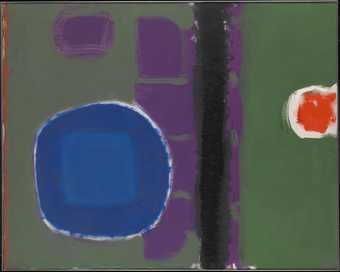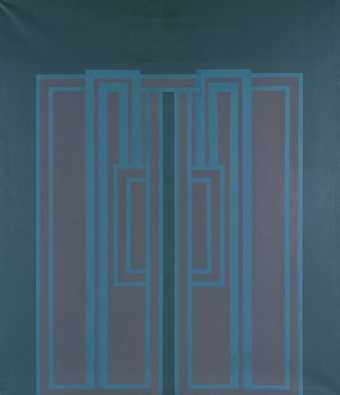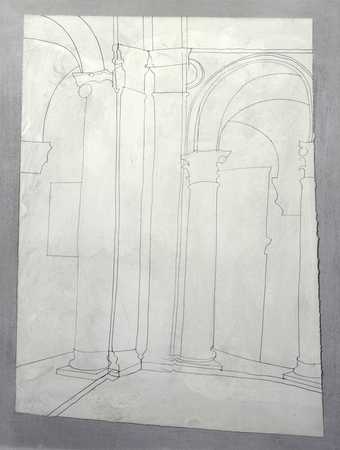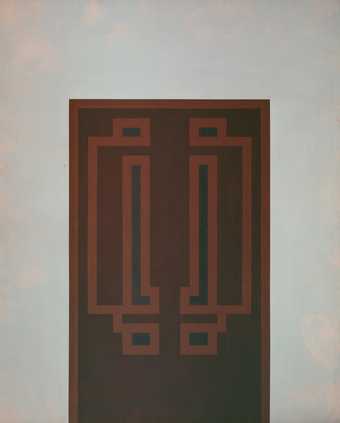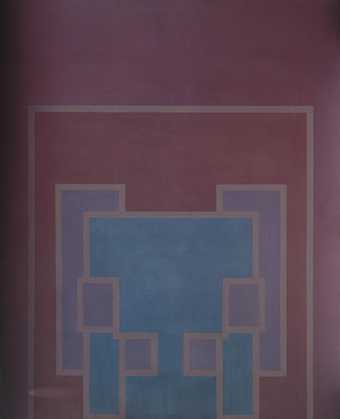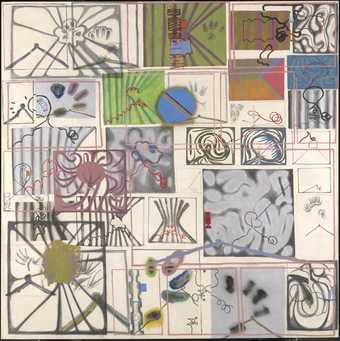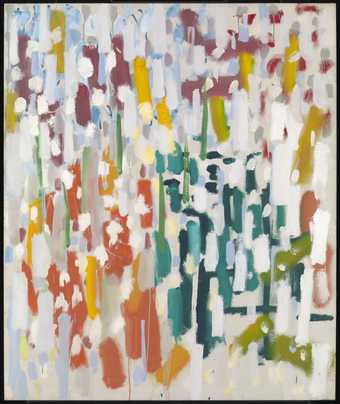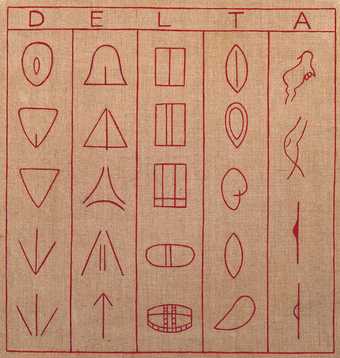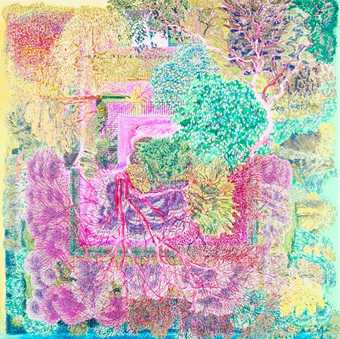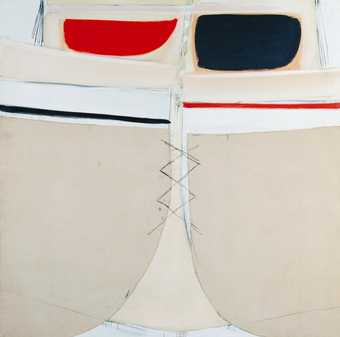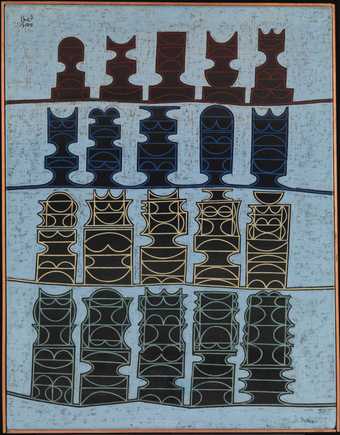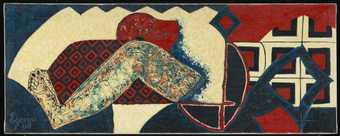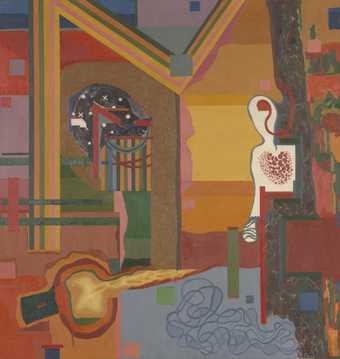
Not on display
- Artist
- Rita Donagh born 1939
- Medium
- Oil paint and graphite on canvas
- Dimensions
- Support: 1524 × 1524 mm
frame: 1543 × 1542 × 33 mm - Collection
- Tate
- Acquisition
- Purchased 1972
- Reference
- T01687
Online caption
This painting charts Donagh’s response to a performance piece by the students she taught at the University of Reading. At the time of this class project four American students were killed by the National Guard at Kent State University during a protest against the Vietnam War. Donagh incorporates references to the shooting into her work: the pink shape refers to a blood stain left on the floor from entrails used in the performance and to the killing of the student protestors. For Donagh the performance brought home the contrast between the relative safety of her group and the Kent State students.
Catalogue entry
Rita Donagh b.1939
T01687 Reflection on Three Weeks in May 1970 1971
Not inscribed’.
Oil and metal paint, pencil and crayon on canvas, 60 x 60 (152.5 x152.5).
Purchased from the artist through Nigel Greenwood Inc. Ltd. (Grant-in-Aid) 1972.
Exh: John Moores Liverpool Exhibition 8, Walker Art Gallery, Liverpool, April–July 1972 (49, repr.); Nigel Greenwood Inc. Ltd, November 1972 (no catalogue).
Lit: Tim Hilton, ‘Liverpool Commentary’, Studio International, June 1972, pp.267–8 (repr.).
The following information is based on a conversation with the artist (16 May 1974); it has also been edited and approved by her. Rita Donagh told the compiler that ‘Reflection on three weeks in May 1970’ was painted in London in Keith Milow’s former studio in Phipp Street, EC2. It was the first studio she had had. She recalled the sense of liberation she felt at that time, knowing that she had ‘somewhere to work and something to say’. Before the 1972 John Moores exhibition, where this picture won a prize and led to her first solo show at Nigel Greenwood’s gallery, she had worked in complete isolation. Painting was an ‘internal thing’, entirely private. She considered herself a teacher rather than an artist.
The subject of the picture is a three-week period of teaching in the Fine Art Department at the University of Reading in May 1970, the beginning of the summer term. The development of the project undertaken then was essentially fortuitous. The only initial stipulation from the head of the department was that the students should be involved in something environmental. They were simply allocated a room for three weeks and a model.
The artist had already established some considerable degree of rapport with this group of students, but they had not until this time been concerned with more than basic course work. Nevertheless many of the group had been profoundly affected by the 1968 student demonstrations and were as concerned, as she herself was to find a way to break through the conventional approach, not simply to seek acceptable solutions in terms of conventional drawing and painting. She worked on the project with the students. Her role was to articulate for them what was going on, to mediate between them and Keith Milow and Alan Davis (then a postgraduate student at Reading), who were directing the proceedings.
In an unpublished statement written in May 1972 at the request of Tim Hilton, who was reviewing the John Moores exhibition, the artist has described something of what took place: ‘On the first day the studio was painted white throughout, including the floor. A student devised a grid as a means of regulating movement within the space. Crosses were put on the grid to mark squares where movement was prohibited. The studio became a stage – action/performance being a natural expression of group activity.’
However, at the time of the ‘Three weeks in May’, Rita Donagh had had no intention of doing a painting on the subject. That decision came only after leaving Reading at the end of term. At this point she abandoned teaching for nearly a year an event of considerable significance in that she had been teaching four days a week and regarded the activity as one of great importance.
The events of those three weeks proved very important for her work, and looking back she found she could focus on them very clearly. She told the compiler that they affected all the participants ‘in terms of one’s own identity’ and also as to ‘what one regarded as the function of art’.
She discovered that she was very conscious of belonging to a different generation from the students and of being committed to painting where they were not. During the sixties she had gone through a period when she found it difficult to rationalise the activity of painting, when she became interested in Nauman and Sonnier, in moving away from a static end-product. This was at a time when the Pop and figurative painting with which she came increasingly in contact had confused the abstract background of her training under Victor Pasmore, whose Basic Course she had followed and by whose ‘marvellous enthusiasm for the modern movement’ she had been stimulated.
The activities of the ‘Three weeks in May’ helped to resolve the problem. ‘They had helped her understand the potential in painting’ and she feels that in some ways she has still not entirely absorbed these lessons. In making a painting on the subject she was able to treat it in a way that was basically abstract, but at the same time contained an important emphasis on content. The subject matter was something she was intimately concerned with, yet could at the same time distance herself from. She had a personal response to the situation, but it was significant in a wider, more collective way because it was shared with others. It was not something done in isolation: she is intensely conscious of the way painting can isolate the artist and that one of the strengths of teaching is that it can counteract this. Although committed to working within the limitations of a flat surface, she had been impressed by Beuys’s statement that it was no longer possible to work alone; it seemed to fit in with her own point of view. Indeed she found it enormously exciting to participate with others on a creative level and in doing so came to see that painting could be part of a much larger whole. The fact that the activity in the studio was essentially performance orientated and that the work which subsequently resulted from this comprised film and. 3D structures (all media she felt beyond the scope of her capabilities) was outweighed by the satisfaction of making a painting about an actual situation.
She was keenly aware that the students with their necessarily restricted area of reference were less inclined to see the episode in perspective. They were much more closely involved with what went on in the space itself. Her main interest in the activity that took place in the studio during the ‘Three weeks’ was in the nature of the space and the way it was changed by the participants. In the painting which came out of it space, time and reference to events are brought together on various levels and in various ways. The artist concluded her 1972 statement: ‘I hoped by using abstract signs and conventions of perspective, to find equivalents for experience and feeling, while at the same time conveying precise information about a particular time and place. I also wanted to investigate the extent to which a painting could encompass those multidimensional events and relationships—add a new element—contribute another part to the whole.’
The central rectangle of the picture represents the plan of the studio and is covered by a grid of squares which corresponds to the actual grid drawn on the floor. Two perspective projections are superimposed on the plan, each with a different eye-level and vanishing point. The first comprises a perspective view of the studio looking across the room to where two walls meet. Then on top of this perceptual, deep space the artist has placed a perspective projection of the plan which forms a very shallow space in relation to the picture plane and represents, so to speak, a ‘conceptual’ space. Superimposed again upon these three levels is a greatly enlarged detail of the plan. This statement of real scale as opposed to diagrammatic scale operates across the entire area of the painting and was used as a device to pull the surface of the painting together. (Its presence is most conspicuous where the two diagonals cross in the left-hand outer panel of the picture). It is repeated on a smaller scale towards the right-hand side of the work, where it acts as a clue to the larger version.
The other markings within the area of the floor plan also function within these perspectives. The crosses relate to the actual crosses on the floor marking taboo areas. The system was that a cross was marked every sixth square. However in one case the student doing the crosses made a mistake and here, on the right-hand side of the picture, the square contains a dotted cross to represent a square ‘called in question’. The dark cross on the right marks the front plane of the plan of the room, it also lies across the line which marks the back wall of the studio. The dark cross on the left-hand side lies in perspective on the floor plan, as does the pinkish shape above it which represents a bloodstain.
This bloodstain is an image with multiple references. It refers to the killing of four students at Kent State University, Ohio, in the first week of May 1970. But it also refers to Richard Hamilton’s record, of this event in his ‘Kent State’ screenprint made from a photograph of a television news broadcast. Rita Donagh derived the bloodstain in this painting from the Hamilton print which she had on the wall in her studio. However the shape in the Hamilton print is undefined, whereas here it is given the precisest of outlines. The students’ confrontation with the National Guard at Kent State made Rita Donagh sharply aware of the privileged position she and her own students were in, of how protected, how isolated they were in comparison with their American and European counterparts. Equally she recognised the parallel with the isolation of an art which refused to allow the dangerous outside world to enter it.
However the bloodstain is not without specific reference to the events within the studio. One of the (most politically concerned) students had in fact worked with blood in that room. He did a performance piece before an audience there which involved ‘a pig’s head in a bag and entrails all over the floor... It was very shocking, an intrusion’.
The artist felt the need to incorporate not only a reference to the fact of blood on the floor, but also to the sense of a stain as something left behind: a reference to time. She could not but be conscious that because the creative things which came out of the ‘Three weeks’ were performative, the situation they were involved with was explicitly a temporal one, something peculiarly of that time. Indeed, looking back on the episode it seemed to her a rather isolated situation, especially in that she gave up teaching shortly afterwards.
In terms of the way it is painted, the bloodstain is the only thing in the room which is visually on the level of reality. ‘It is pink. It looks like blood… It’s the only point where the inner and outer worlds meet.’ In general the painting is concerned with the way in which fact can be rendered into the abstract language of painting. The artist told the compiler that she felt that ‘if a painting was to be non-figurative it must have some power beyond the physical facts it stated’.
To the right and left of the central rectangle, side panels contain references to the artist’s personal life, external to events in Reading, and employing two further conventions of linear expression. In the left panel there is a long irregularly undulating line, which derives from the outline of the back of one of a group of boys used in the painting immediately preceding this one—’Taking the trouble to sound it’. The line first appears in a 1965 painting ‘42nd St.’ which itself contains a Warhol reference. The curving lines on the right are derived from Thoreau’s drawing of cross-sections through Walden pond, and are taken from Robert F. Stowell, A Thoreau Gazetteer, edited by William L. Howarth, Princeton University Press, 1970 (Map 4, p.6). (In a subsequent painting entitled ‘New Bearings’, 1972, the artist used the same drawing by Thoreau again.) In her 1972 statement on the Tate painting she described these two configurations as ‘References to landscape and man; an attempt to connect with a less private reality’.
As the grid and crosses were devices to structure the space of both room and painting, the dark and light strips around the edge of the picture have visual relevance as pictorial framing devices. The artist used a similar scheme in ‘Taking the trouble to sound it’ based on the Golden Section, where the elaborate framing construction goes right into the picture. However, she does not regard her pictures as objects. The frame is there to separate the world they depict from the external world.
Drawing is extremely important to Rita Donagh and she felt that in many ways the activity in which she took part during the ‘Three weeks’ could itself be compared to drawing. She told the compiler: ‘I can’t work in painting until I’ve resolved things graphically’. Drawings are essential, since to work out the different perspectives in such a painting as the Tate’s is extremely complicated. Numerous studies for it include a small painting in which the artist worked out the comparison of the detail of the plan actual size with a scaled down version of it. There is also a drawing which establishes the precise shape of the bloodstain in outline and perspective and also incorporates a photographic image of the room with a cross on the floor and a reference to the model draped in a sheet, who does not however figure in the final picture.
Published in The Tate Gallery Report 1972–1974, London 1975.
Explore
- abstraction(8,615)
-
- from recognisable sources(3,634)
-
- man-made(999)
- non-representational(6,161)
-
- geometric(3,072)
- formal qualities(12,454)
-
- diagrammatic(799)
- workspaces(918)
-
- studio(549)
- inscriptions(6,664)
-
- cross(49)
You might like
-
Patrick Heron Green and Purple Painting with Blue Disc : May 1960
1960 -
Robyn Denny Life Line I
1963 -
Ben Nicholson OM May 1962 (Urbino - footsteps in the dust)
1962 -
Robyn Denny First Light
1965–6 -
Robyn Denny Garden
1966–7 -
Derek Boshier The Identi-Kit Man
1962 -
Bernard Cohen Matter of Identity I
1963 -
Peter Phillips The Entertainment Machine
1961 -
Patrick Heron Azalea Garden : May 1956
1956 -
John Murphy Delta
1978–9 -
Adrian Berg Gloucester Gate, Regent’s Park, May
1982 -
Sir Terry Frost May 1962 (Stays)
1962 -
Anwar Jalal Shemza Chessmen One
1961 -
Uzo Egonu Woman in Grief
1968 -
Vivan Sundaram May 68
1968

